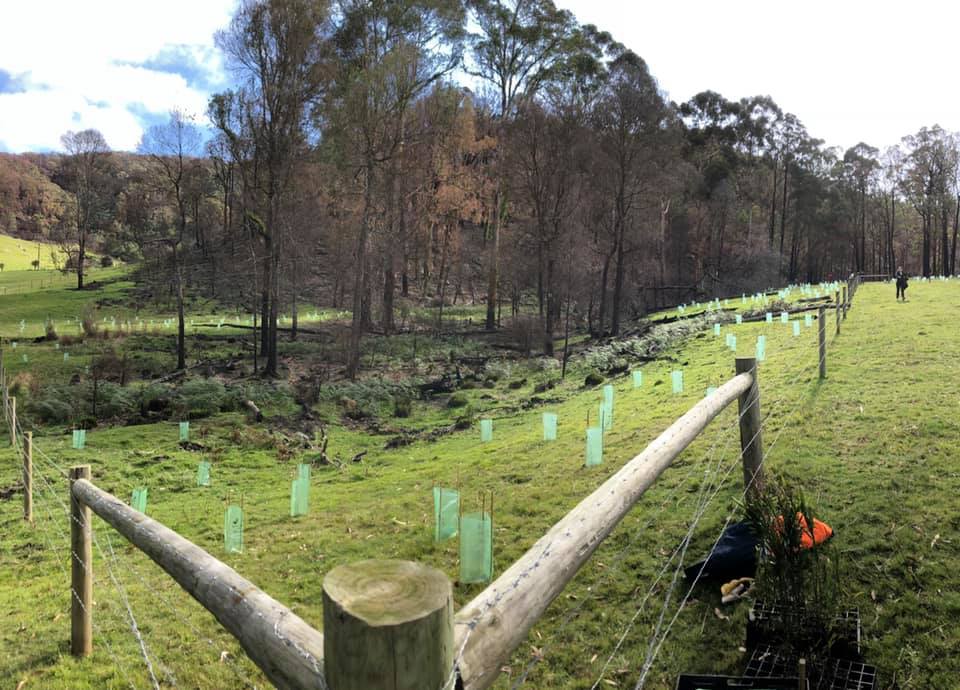Protecting and improving the environmental and biodiversity values on public and private lands within the Cannibal Creek catchment
The Cannibal Creek Catchment Biodiversity Project was instigated in 2016 following discussions between representatives of local community groups and Cardinia Shire. The key objective of the project has been to protect and improve the environmental and biodiversity values on public and private lands within the Cannibal Creek catchment. This has been achieved by securing funding to support landowners and managers to control pest plants and animals, and to protect or increase areas of remnant vegetation by revegetation or exclusion fencing. The project provides engagement and capacity building opportunities for a diverse range of groups within the community with activities associated with the project objectives including weed control or revegetation, or biodiversity monitoring activities. The project has conducted a very successful pest animal control program over three years engaging volunteer controllers to target key pest animal species including feral deer, Red Fox, European Rabbit.
The project area originally focused on the riparian zone and allotments adjoining the Cannibal Creek, and public reserves such as Mt Cannibal Flora and Fauna Reserve and Bunyip Sanctuary. Since 2016 the project area has expanded to support activities over an area extending from Tynong North Road east to the Bunyip River and from Princes Freeway north to Tonimbuk-Gembrook Rd to include the catchments of Dingo and Diamond Creeks. The project has been able to support or complement environmental works with agency stakeholders including Cardinia Shire, Melbourne Water and Parks Victoria. Recent collaboration with Parks Victoria, has supported weed control activities and is providing potential for future project activities within Bunyip State Park and other sites to be incorporated into the project.
Following the 2019 Bunyip bushfire the project supported landholders with re-establishing or installing exclusion fencing and revegetation, trialed deer exclusion fencing to protect significant vegetation, supported stakeholder groups with flora and Aboriginal Cultural Heritage surveys and conducted post-fire biodiversity monitoring.
As a key tributary to the Bunyip River, the aims and activities of the Cannibal Creek Catchment Biodiversity Project improves the environmental values of both the Cannibal Creek catchment and contributes to the ecosystem health of the Bunyip River catchment within and downstream of the project area, and Western Port.
Themes and Local Areas
| Primary Theme: | Native vegetation |
| Other Themes: | Waterways, Wetlands, Native animals, Traditional Owners and Aboriginal Victorians, Communities |
| Primary Local Area: | Casey, Cardinia & Baw Baw |
| Other Local Areas: | – |
| Project location: | The Cannibal Creek Catchment Biodiversity Project originally targeted the riparian corridor of the Cannibal Creek from Pooley Rd Tynong North to the confluence with the Bunyip River, and specific Cardinia Shire Reserves (Mt Cannibal Flora and Fauna Reserve, Bunyip Sanctuary). Since 2016 it has now expanded to support landholders and agencies with natural resource management projects within an area bounded by Tynong North Road east to Bunyip River, Princes Freeway north to Bunyip State Park and Tonimbuk-Gembrook Road corridor. |
| Scale of the project: | Local |
| New or continuing work: | Continuing/building on previous work |
Project partners
| Lead organisation: | Westernport Catchment Landcare Network |
| Key partners: | Cardinia Shire Council, Cannibal Creek Landcare, Bunyip Landcare, Friends of Mt Cannibal, Cannibal Creek Reserve CoM, Melbourne Water, Parks Victoria, Department of Energy, Environment and Climate Action (DEECA) |
| Registered Aboriginal Party/s relevant to the project or its area: | Bunurong Land Council Aboriginal Corporation |
Investment opportunities
| Opportunities for investors within this project start from: | $$$ (Hundreds of thousands of dollars) |
| Estimated scale of investment for full project implementation: | $$$ (Hundreds of thousands of dollars) |
| Estimated timeframe for full project implementation: | 2-10 years |
Contribution toward targets
| Primary Regional Catchment Strategy target and contribution to its achievement: | This project will contribute to the following region-wide targets: Revegetation – At least 33,000 hectares of revegetation established in the region between 2017 and 2050 (an average of at least 1,000 hectares per year). Pest and weed control – At least 316,800 hectares of pest herbivore control and 105,600 hectares of weed control undertaken in priority areas in this region between 2017 and 2050 (an average of at least 9,600 and 3,200 hectares per year respectively). Diversity of native animals – Maintain the diversity of native animal species in the region from 2021 to 2050 and ensure the populations are sustainable, secure, healthy and resilient. Community volunteering – Community volunteering for natural resource management surpasses 1 million hours per year. Landcare group health – Landcare groups across the region maintain an average group health score of at least 3.7/5. |
| Relevant Biodiversity 2037 goal: | Undertake weed or pest herbivore control to maintain and enhance vegetation quality in priority areas |
| Relevant National Landcare Program priority: | Soil/biodiversity – Projects that will protect and enhance on-farm remnant native vegetation |



